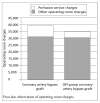Short-term complications and resource utilization in matched subjects after on-pump or off-pump primary isolated coronary artery bypass
- PMID: 15568655
- PMCID: PMC3655795
Short-term complications and resource utilization in matched subjects after on-pump or off-pump primary isolated coronary artery bypass
Abstract
Background: Studies suggest that patients who undergo off-pump coronary artery bypass grafting (OPCABG) have fewer short-term complications and use fewer inpatient resources than do patients who undergo standard coronary artery bypass grafting (CABG) with extracorporeal circulation. However, dissimilarity between groups in risk factors for complications has hindered interpretation of results.
Objectives: To compare the prevalence of selected complications (atrial fibrillation, stroke, reoperation, and bleeding) and inpatient resource utilization (length of stay, discharge disposition, total charges) between subjects undergoing primary isolated CABG or OPCABG who were matched with respect to key risk factors.
Methods: Retrospective, causal-comparative survey conducted in 1 center for 18 months. Patients who underwent primary isolated CABG or OPCABG were matched for sex, age (within 2 years), left ventricular ejection fraction (within 0.05), and graft-patient ratio (exact match) and compared for prevalence of new-onset atrial fibrillation, stroke, reoperation within 24 hours, and bleeding. Statistical analysis included Wilcoxon and t tests for paired comparisons.
Results: The sample (107 matched pairs) was 63% male, with a mean age of 66 (SD 9.5) years, a mean left ventricular ejection fraction of 0.51 (SD 0.13), and a mean graft-patient ratio of 3.41 (SD 0.74). The 2 groups did not differ significantly in New York Heart Association class (P = .43), Acute Physiology and Chronic Health Evaluation III score (P = .22), postoperative beta-blocker use (P = .73), or comorbid conditions. None of the complications examined differed significantly between pairs.
Conclusion: Patients with comparable risk profiles have similar prevalences of selected complications after CABG and OPCABG.
Similar articles
-
Preoperative β-blocker use in coronary artery bypass grafting surgery: national database analysis.JAMA Intern Med. 2014 Aug;174(8):1320-7. doi: 10.1001/jamainternmed.2014.2356. JAMA Intern Med. 2014. PMID: 24934977
-
Off-pump versus on-pump coronary artery bypass grafting in patients with left ventricular dysfunction.J Thorac Cardiovasc Surg. 2016 Apr;151(4):1092-8. doi: 10.1016/j.jtcvs.2015.11.023. Epub 2015 Nov 22. J Thorac Cardiovasc Surg. 2016. PMID: 26725715
-
Atrial fibrillation after conventional and off-pump coronary artery bypass grafting: two opposite trends in timing of atrial fibrillation occurrence?Med Sci Monit. 2003 Mar;9(3):CR137-41. Med Sci Monit. 2003. PMID: 12640343
-
Off-pump coronary artery bypass grafting improves short-term outcomes in high-risk patients compared with on-pump coronary artery bypass grafting: Meta-analysis.J Thorac Cardiovasc Surg. 2016 Jan;151(1):60-77.e1-58. doi: 10.1016/j.jtcvs.2015.08.042. Epub 2015 Aug 15. J Thorac Cardiovasc Surg. 2016. PMID: 26433633 Review.
-
Does off-pump coronary artery bypass graft surgery have a beneficial effect on long-term mortality and morbidity compared with on-pump coronary artery bypass graft surgery?Interact Cardiovasc Thorac Surg. 2014 Jul;19(1):149-59. doi: 10.1093/icvts/ivu075. Epub 2014 Mar 21. Interact Cardiovasc Thorac Surg. 2014. PMID: 24659552 Review.
Cited by
-
Neurologic complications of cardiac surgery: current concepts and recent advances.Curr Cardiol Rep. 2006 Feb;8(1):9-16. doi: 10.1007/s11886-006-0004-3. Curr Cardiol Rep. 2006. PMID: 16507229 Review.
-
Sex differences in resource use after on-pump and off-pump coronary artery bypass surgery: a propensity score-matched cohort.Can J Cardiol. 2009 May;25(5):e151-6. doi: 10.1016/s0828-282x(09)70498-2. Can J Cardiol. 2009. PMID: 19417865 Free PMC article.
-
Incidence of atrial fibrillation after off-pump versus on-pump coronary artery bypass grafting: A meta-analysis of randomized clinical trials and propensity score matching trials.J Huazhong Univ Sci Technolog Med Sci. 2017 Dec;37(6):956-964. doi: 10.1007/s11596-017-1834-5. Epub 2017 Dec 21. J Huazhong Univ Sci Technolog Med Sci. 2017. PMID: 29270760
References
-
- Kirklin JK, Westaby S, Blackstone EH, Kirklin JW, Chenowith DE, Pacifico AD. Complement and the damaging effects of cardiopulmonary bypass. J Thorac Cardiovasc Surg. 1983;86:845–857. - PubMed
-
- Mathew JP, Parks R, Savino JS, et al. Atrial fibrillation following coronary artery bypass graft surgery: predictors, outcomes, and resource utilization. MultiCenter Study of Perioperative Ischemia Research Group. JAMA. 1996;276:300–306. - PubMed
-
- Edmunds LH., Jr. The evolution of cardiopulmonary bypass: lessons to be learned. Perfusion. 2002;17:243–251. - PubMed
-
- Almassi GH, Sommers T, Moritz TE, et al. Stroke in cardiac surgical patients: determinants and outcome. Ann Thorac Surg. 1999;68:391–397. - PubMed
-
- Place DG, Peragallo RA, Carroll J, Cusimano RJ, Cheng DC. Postoperative atrial fibrillation: a comparison of off-pump coronary artery bypass surgery and conventional coronary artery bypass graft surgery. J Cardiothorac Vasc Anesth. 2002;16:144–148. - PubMed
Publication types
MeSH terms
Substances
Grants and funding
LinkOut - more resources
Full Text Sources
Medical

